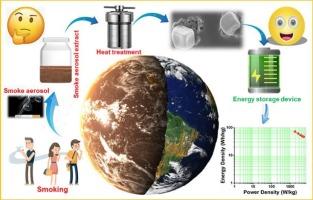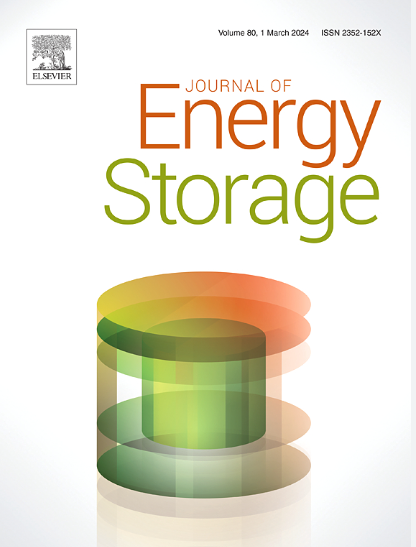Extraction and modification of cigarette smoke aerosol derived nanoparticle for supercapacitor
IF 8.9
2区 工程技术
Q1 ENERGY & FUELS
引用次数: 0
Abstract
Developing sustainable solutions for utilizing toxic pollutants in different applications is a significant challenge. This article explores how cigarette smoke—an aerosol containing numerous hazardous organic compounds and metals—was captured and transformed into metal and carbon-based nanoparticles (carbon dots) through a straightforward hydrothermal process. Cigarette smoke extract was prepared in water and then hydrothermally treated to obtain solid particulates. These metal and carbon-based nanoparticles were subsequently combined with carbon black and carbon nanotubes to enhance their stability and electrochemical activity. An asymmetric supercapacitor was developed by utilizing these modified nanoparticles to demonstrate the potential of cigarette smoke aerosol-derived nanomaterials for energy storage. Photoluminescence and TEM analysis confirmed the formation of carbon dots, while FESEM and elemental mapping validated the presence of metal-based nanoparticles. The asymmetric supercapacitor device was fabricated with carbon black modified aerosol-derived carbon and metal-based nanoparticles achieved a specific capacitance of 161 F/g along with energy and power density of 72 W h/kg and 1798 W/kg, at 1 A/g current density, respectively. Overall, this study illustrates that capturing and converting hazardous aerosols can simultaneously tackle two critical issues: environmental pollution and the demand for energy storage, using a simple and scalable approach applicable to various toxic aerosol systems.

用于超级电容器的香烟烟雾衍生纳米粒子的提取和改性
开发可持续的解决方案,在不同应用中利用有毒污染物是一项重大挑战。本文探讨了香烟烟雾--一种含有大量有害有机化合物和金属的气溶胶--如何通过直接的水热法捕获并转化为金属和碳基纳米颗粒(碳点)。香烟烟雾提取物在水中制备,然后通过水热处理获得固体颗粒。这些金属和碳基纳米颗粒随后与碳黑和碳纳米管结合,以增强其稳定性和电化学活性。利用这些改性纳米粒子开发了一种不对称超级电容器,证明了香烟烟雾气溶胶衍生纳米材料在能量存储方面的潜力。光致发光和 TEM 分析证实了碳点的形成,而 FESEM 和元素图谱则验证了金属基纳米粒子的存在。用炭黑修饰的气溶胶衍生碳和金属基纳米粒子制造的不对称超级电容器装置在 1 A/g 电流密度下的比电容达到 161 F/g,能量和功率密度分别为 72 W h/kg 和 1798 W/kg。总之,这项研究表明,利用一种适用于各种有毒气溶胶系统的简单、可扩展的方法,捕获和转换有害气溶胶可以同时解决两个关键问题:环境污染和能源储存需求。
本文章由计算机程序翻译,如有差异,请以英文原文为准。
求助全文
约1分钟内获得全文
求助全文
来源期刊

Journal of energy storage
Energy-Renewable Energy, Sustainability and the Environment
CiteScore
11.80
自引率
24.50%
发文量
2262
审稿时长
69 days
期刊介绍:
Journal of energy storage focusses on all aspects of energy storage, in particular systems integration, electric grid integration, modelling and analysis, novel energy storage technologies, sizing and management strategies, business models for operation of storage systems and energy storage developments worldwide.
 求助内容:
求助内容: 应助结果提醒方式:
应助结果提醒方式:


